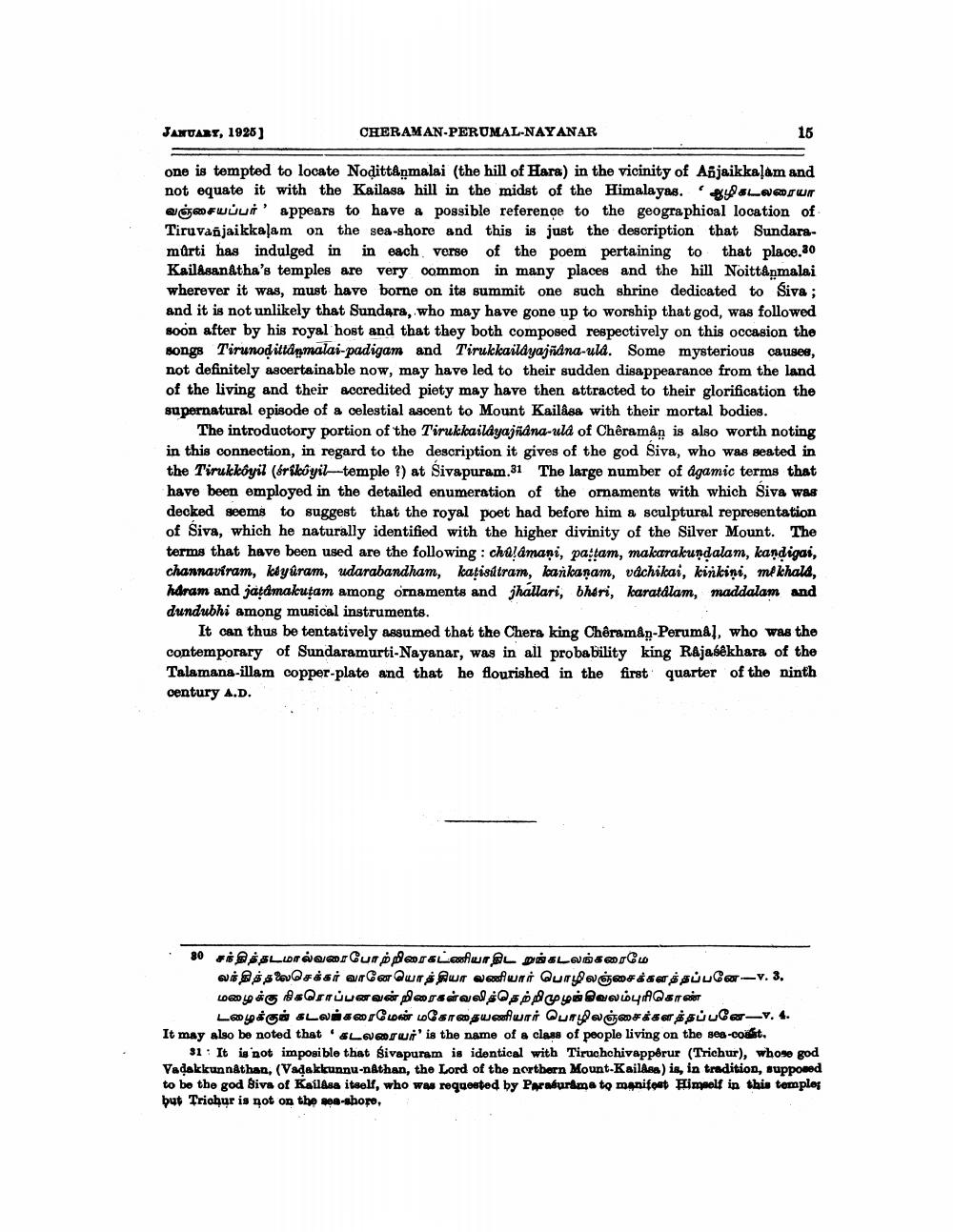________________
JANUARY, 1925]
one is tempted to locate Noḍittanmalai (the hill of Hara) in the vicinity of Añjaikkalam and not equate it with the Kailasa hill in the midst of the Himalayas.
CHERAMAN-PERUMAL-NAYANAR
15
La
шür' appears to have a possible reference to the geographical location of Tiruvañjaikkalam on the sea-shore and this is just the description that Sundaramûrti has indulged in in each verse of the poem pertaining to that place.30 Kailasanatha's temples are very common in many places and the hill Noittânmalai wherever it was, must have borne on its summit one such shrine dedicated to Śiva; and it is not unlikely that Sundara, who may have gone up to worship that god, was followed soon after by his royal host and that they both composed respectively on this occasion the songs Tirunoḍittanmalai-padigam and Tirukkailayajñana-uld. Some mysterious causes, not definitely ascertainable now, may have led to their sudden disappearance from the land of the living and their accredited piety may have then attracted to their glorification the supernatural episode of a celestial ascent to Mount Kailasa with their mortal bodies.
The introductory portion of the Tirukkailayajñana-ula of Chêramân is also worth noting in this connection, in regard to the description it gives of the god Siva, who was seated in the Tirukkôyil (ériköyil-temple ?) at Sivapuram.31 The large number of ågamic terms that have been employed in the detailed enumeration of the ornaments with which Siva was decked seems to suggest that the royal poet had before him a sculptural representation of Siva, which he naturally identified with the higher divinity of the Silver Mount. The terms that have been used are the following: chúlámani, paṭṭam, makarakundalam, kaṇḍigai, channaviram, kéyûram, udarabandham, katisútram, kankanam, váchikai, kinkini, mekhald, haram and jatamakuṭam among ornaments and jhallari, bhéri, karatålam, maddalam and dundubhi among musical instruments.
It can thus be tentatively assumed that the Chera king Chêramân-Perumâl, who was the contemporary of Sundaramurti-Nayanar, was in all probability king Rajasekhara of the Talamana-illam copper-plate and that he flourished in the first quarter of the ninth century A.D.
80 சந்தித்தடமால்வரை போற்றிரைகட்ணியாதிட றுங்கடலங்கரைமே லந்தித்தலைசெக்கர் வானேயொத்தியா வணியார் பொழிலஞ்சைக்களத்தப்பனே - V. 3. மழைக்கு நிகரொப்பனவன்றிரைகள்வலித்தெற்றி முழங்கிவலம்புரிகொண்
டழைக்குங் கடலங்கரைமேன் மகோதையணியார் பொழிலஞ்சைக்களத்தப்பனே V.4.
It may also be noted that Loverшr' is the name of a class of people living on the sea-coast.
31 It is not imposible that Sivapuram is identical with Tiruchchivappêrur (Trichur), whose god Vadakkunnathan, (Vadakkunnu-nathan, the Lord of the northern Mount-Kailasa) is, in tradition, supposed to be the god Siva of Kailasa itself, who was requested by Parasurama to manifest Himself in this temple: but Trichur is not on the sea-shore,




